Geometry Dash: The Enduring Rhythm of Precision and Creation
Introduction: A Simple Premise, Endless Complexity
In the vast landscape of video games, where hyper-realistic graphics and complex narratives often dominate,
Geometry Dash stands out as a vibrant, deceptively simple, and incredibly challenging rhythm-based platformer. Created by Swedish developer Robert Topala (known as RobTop Games), Geometry Dash first launched on mobile devices (iOS and Android) on
August 13, 2013, later expanding to Windows and macOS in December 2014. Its premise is straightforward: control an icon through a series of obstacle courses synchronized to pulsating electronic music, timing jumps and maneuvers with pinpoint precision. However, beneath this accessible surface lies a game of immense depth, a thriving community of creators, and a relentless pursuit of mastery that has kept millions hooked for over a decade. This article will delve into the core mechanics that define Geometry Dash, its innovative level editor, the dedicated community that fuels its content, its impressive longevity, and its unique place in the gaming world.
The Origins of a Phenomenon: From Mobile Gem to PC Sensation
Geometry Dash's journey began as a mobile-first experience, designed to be picked up and played in short bursts, but its compelling gameplay quickly transcended its initial platform.
Humble Beginnings and Rapid Growth
Robert Topala developed Geometry Dash primarily on his own, focusing on a core gameplay loop that combined rhythmic timing with platforming challenges. The initial mobile release garnered significant attention for its addictive nature and satisfying difficulty. The game's success on mobile prompted its port to PC (Steam) in 2014, opening it up to a new audience and allowing for more precise controls using keyboards and mice, which many players found essential for tackling the game's most challenging levels. This multi-platform availability broadened its reach and cemented its status as a cross-device hit.
Inspiration and Iterative Design
While details on direct inspirations are not widely publicized, the game clearly draws from the "runner" genre, but adds its own unique spin with its tight rhythm synchronization and the groundbreaking level editor. RobTop's approach has always been iterative, gradually adding new features, game modes, and editor tools through major updates, rather than releasing entirely new games. This consistent evolution has been key to keeping the game fresh and engaging for its long-term player base.
Core Gameplay: Rhythm, Reflexes, and Icon Transformations
At its heart, Geometry Dash is a test of timing and reflexes, where every click or tap must be perfectly synchronized with the music and the environment.
Simple Controls, Complex Outcomes
Players control an icon (initially a cube) that automatically moves forward. The primary interaction is a single input (tap/click) to make the icon jump, fly, or switch gravity, depending on its current form. The simplicity of the controls belies the complex sequences of obstacles players must navigate, from sharp spikes and moving blocks to intricate timing puzzles and hidden paths.
- Rhythm Synchronization: The music isn't just background noise; it's an integral part of the gameplay. Obstacles and trigger events are often perfectly synced to the beat, allowing players to internalize the rhythm of a level and anticipate upcoming challenges. This auditory cue is crucial, especially in higher difficulty levels.
- Instant Restart: A single mistake means an instant, unforgiving restart from the beginning of the level (or the last checkpoint in Practice Mode). This "trial and error" loop, while frustrating for some, is central to the game's addictive nature, pushing players to refine their muscle memory and pattern recognition.
Diverse Game Modes and Icon Forms
The game features several distinct "game modes" or icon transformations, each altering the fundamental control scheme and adding new layers of challenge.
- Cube: The default mode, where a single tap makes the cube jump. Holding down performs continuous jumps.
- Ship: The icon transforms into a ship, and holding down makes it fly upwards, while releasing makes it fall. Players must navigate through narrow vertical gaps.
- Ball: Tapping in this mode flips the icon's gravity, making it stick to the ceiling or floor.
- UFO: Taps make the UFO flap upwards, allowing for controlled, multi-jump sequences.
- Wave: Holding down makes the wave move diagonally upwards, and releasing makes it move diagonally downwards, creating a zigzag pattern.
- Robot: Similar to the cube, but holding down allows for variable jump heights.
- Spider: Like the ball, it instantly teleports between the floor and ceiling with each tap, but with unique movement patterns.
- Swing (Newest): Introduced in Update 2.2, this mode changes gravity with each tap, similar to the ball, but with a pendulum-like swing movement.
Furthermore, levels can include speed changes, size changes (mini icons), and dual modes (controlling two icons simultaneously), all adding to the gameplay variety and complexity.
The Level Editor: Unleashing Community Creativity
Perhaps the most revolutionary aspect of Geometry Dash is its comprehensive
level editor. This powerful tool empowers players to design, build, and share their own custom levels, transforming the game into an infinite source of content.
Intuitive Tools, Endless Possibilities
The editor allows creators to place a vast array of objects, obstacles, triggers, and decorative elements. Despite its complexity, it's designed with an intuitive interface that allows new users to quickly grasp the basics while providing advanced tools for experienced builders.
- Object Placement: Players can drag and drop blocks, spikes, saws, portals, orbs, and various decorative elements onto the timeline.
- Triggers: A sophisticated trigger system allows for complex automation, including moving objects, changing colors, altering gravity, spawning effects, and controlling in-game music. This is where much of the game's visual and mechanical creativity truly shines.
- Customization: Nearly every element can be customized in terms of color, size, rotation, and animation, allowing for truly unique and personalized levels.
A Community-Driven Content Mill
The level editor has fostered one of the most prolific and dedicated user-generated content communities in gaming. Millions of player-created levels are uploaded and shared online, ranging from incredibly easy "auto levels" to absurdly difficult "Demon" levels.
- Rating System: Players can rate the difficulty of user-created levels (Easy, Normal, Hard, Harder, Insane, Demon), and "Demon" levels are further categorized into Easy, Medium, Hard, Insane, and Extreme Demon. This community-driven rating system helps players find challenges appropriate to their skill level.
- Gauntlets and Map Packs: Curated collections of user levels, offering themed challenges and a structured way to experience some of the best community creations.
- Verification System: For a custom level to be "rated" by RobTop (and thus become discoverable and award stars), it must be verified by its creator, meaning they must beat their own level from start to finish. This ensures playability and prevents impossible levels from cluttering the ranked list.
Pros and Cons: A Look at Geometry Dash's Strengths and Weaknesses
Geometry Dash's unique blend of mechanics and community content comes with its own set of advantages and disadvantages.
Pros:
- Infinite Replayability (Rating: 10/10): The user-generated content model means there is an endless supply of new levels, ensuring players always have fresh challenges to tackle.
- Addictive Gameplay Loop (Rating: 9/10): The simple controls, instant restarts, and satisfying feeling of overcoming a difficult section create a highly addictive "just one more try" mentality.
- Fair Monetization (Rating: 9/10): The full game is a one-time purchase with no in-game ads, loot boxes (in the main game), or pay-to-win mechanics. Spin-off "Lite" versions are free.
- Strong Community (Rating: 9/10): A passionate and active community thrives around level creation, challenge videos, and speedrunning, providing a constant source of inspiration and engagement.
- High Skill Ceiling (Rating: 9/10): While easy to pick up, mastering the game's mechanics, especially for Demon levels, requires immense dedication, precision, and memorization, offering a deep challenge for competitive players.
- Excellent Music Integration (Rating: 8/10): The rhythm-based gameplay is enhanced by a diverse library of electronic music, making each level feel like a musical journey.
- Platformer Mode (New Feature, Rating: 8/10): Update 2.2's introduction of a free-moving platformer mode opens up entirely new gameplay possibilities and creative avenues for level designers.
Cons:
- Frustrating Difficulty (Rating: 6/10 for casuals): The unforgiving nature of instant restarts and the sheer difficulty of many levels can be incredibly frustrating for casual players who might not have the patience for trial-and-error.
- Steep Learning Curve for Editor (Rating: 5/10): While intuitive at a basic level, mastering the level editor's advanced features and triggers requires significant time and effort.
- Reliance on User Content (Rating: 7/10 for consistency): While a strength, the quality of user-created levels can vary wildly, requiring players to sift through many uninspired creations to find gems.
- Long Gaps Between Official Updates (Rating: 4/10): Historically, RobTop has taken extended periods (years) between major updates, leading to community impatience, though Update 2.2 finally broke a long drought.
- Potential for Repetitive Music (Rating: 6/10): While the music is excellent, hearing the same tracks hundreds or thousands of times while attempting a difficult level can become repetitive.
- Small Screens (Mobile, Rating: 6/10): While playable on mobile, the precise nature of the game often makes it more comfortable and less prone to accidental taps on larger screens or with physical controls.
Updates and Longevity: The Decade-Long Journey
Geometry Dash's remarkable longevity is primarily due to its innovative core design and RobTop's commitment to delivering significant, albeit infrequent, updates.
The Anticipation of 2.2
For years, the community eagerly awaited
Update 2.2, which finally arrived in late 2023. This monumental update introduced a wealth of new features, including:
- Platformer Mode: A revolutionary addition that allows for non-auto-scrolling, free-moving levels, fundamentally changing how levels can be designed and played.
- New Game Mode (Swing): Expanding the icon transformations.
- Hundreds of New Triggers and Editor Tools: Empowering creators with unprecedented control and possibilities.
- New Official Levels: Including the long-awaited "Dash" level.
- Quality of Life Improvements: Enhancements to menus, UI, and overall performance.
The release of 2.2 injected a massive surge of new content and renewed interest into the game, showcasing RobTop's dedication despite the long development cycles.
Spin-off Titles and Consistent Support
Beyond the main game, RobTop has also released several free spin-off titles that offer a taste of Geometry Dash's gameplay:
- Geometry Dash Lite (2013): A free version with limited levels.
- Geometry Dash Meltdown (2015): Features three exclusive levels with a fire/lava theme.
- Geometry Dash World (2016): Offers unique mini-levels and a broader introduction to the game's mechanics.
- Geometry Dash SubZero (2017): Three exclusive levels with an ice/winter theme.
These spin-offs have served to attract new players and keep the brand visible during periods between major updates for the main game.
The Community: Architects of the Impossible
The Geometry Dash community is arguably its greatest asset, transforming the game from a simple platformer into a dynamic, ever-expanding creative ecosystem.
Master Builders and Demon Slayers
The community is home to incredibly talented level designers who push the boundaries of what's possible with the editor, creating levels of astounding complexity, visual flair, and brutal difficulty. Simultaneously, a dedicated subset of "Demon Slayers" relentlessly practice and conquer these seemingly impossible levels, often sharing their triumphs through viral videos and streams. This symbiotic relationship between creators and players fuels the game's competitive and aspirational aspects.
Competitive Play and Speedrunning
Beyond simply beating levels, the community engages in various forms of competitive play, including:
- Demon List: An unofficial, community-managed list ranking the hardest "Demon" levels in the game, a constant source of prestige and challenge.
- Speedrunning: Players compete to complete levels as fast as possible, often exploiting glitches or finding optimal routes.
- Level Competitions: Community-organized contests for level building, fostering innovation and showcasing new talent.
This vibrant meta-game built around user-generated content ensures the game's perpetual relevance.
Conclusion: A Timeless Classic of Rhythm and Precision
Geometry Dash, now over a decade old, has defied expectations to become a true mobile and PC classic. Its simple yet infinitely deep rhythm-based platforming gameplay, combined with an unparalleled user-generated content ecosystem, has created a game that continually reinvents itself. RobTop's vision, coupled with the boundless creativity of its community, has ensured that there is always a new challenge to overcome, a new beat to master, and a new level to explore.
While its unforgiving difficulty and long waits between official updates might deter some, those who embrace the "trial and error" loop and the pursuit of mastery find an incredibly rewarding experience. Geometry Dash is more than just a game; it's a testament to the power of community-driven content, a celebration of precise execution, and a reminder that compelling gameplay, synchronized to a killer soundtrack, can create an enduring legacy, one perfectly timed jump at a time. As the game continues to evolve with future updates, its rhythmic pulse will undoubtedly continue to captivate and challenge players for years to come.
































